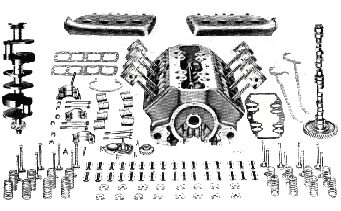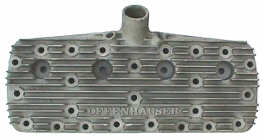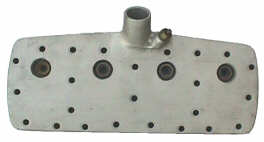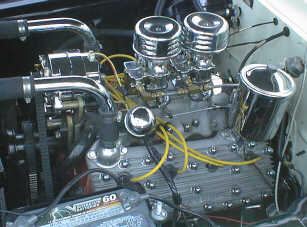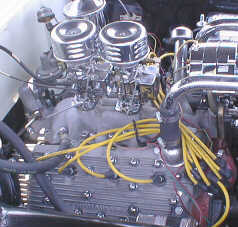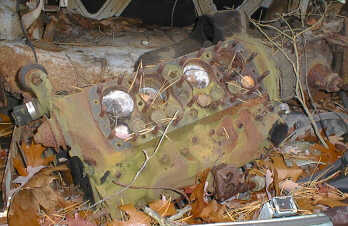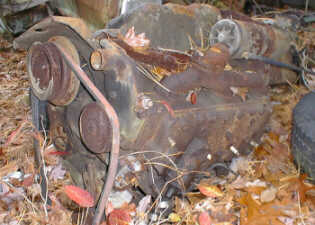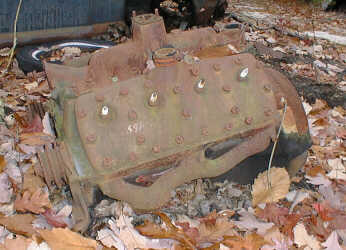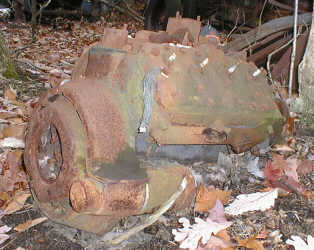|
1932 - Model 18 - 65 HP @ 3400
Introduced in 1932, the first Flathead used a gear-driven camshaft with
a fabric cam gear. Solid valve tappets. The 221 CID engine had a bore
and stroke of 3-1/6" x 3-3/4". The compression ratio was 5.5:1. Hey, they
had some quality gasoline in 1932, huh! Cylinder heads were clamped to
the block by 21 studs. The water pumps were mounted on the heads. 18mm
spark plugs were used. Intake and exhaust valves were both 1.54" diameter,
with 5/16" valve stems, running in tungsten chromium steel guides.
The seats were integral with the block, no inserts were
used. The connecting rods measured 7", center to center, with full-floating
bearing shells. The crank pin was 2" in diameter. The forged steel crankshaft
ran in only three, 2" main bearings of poured babbitt. The carburetor was
a Detroit Lubricator single-barrel. The bellhousing is cast integral with the block.
1933 - Model 40 - 75 @ 3800
Change to aluminum cylinder heads with compression raised to 6.3:1
1934 - Model 40A - 85 @ 3800
Carburetion changed to the Stromberg 48 two barrel with 1.03"
venturis.
Good for an extra 10 HP.
1935 - Model 48 - 85 @ 3800
No significant changes.
1936 - Model 68 - 85 @ 3800
Changed from aluminum to steel pistons.
1937 - Model 78 - 85 @ 3800
Major face lift. The cylinder heads were redesigned, moving the water outlets
to the center of the head and the water pumps moved to the block. This helped
solve problems with overheating. Head-mounted pumps tended to cavitate in
the steam rather than pump cool water. Pistons gained domes while the combustion
chamber shape was revised to accommodate them. This added squish and reduced knock.
Compression also dropped to 6.1:1. The carburetor was changed to the Stromberg 97.
The cast iron crankshaft's main bearings were enlarged to 2.4" and the babbitt
was replaced with modern inserts.
1938 - Model 81A - 85 @ 3800
Spark plugs changed to 14mm thread.
1939 - Model 91A - Ford 85 @ 3800, Mercury 95 @ 3600
The Flathead revised for the new Mercury car line.
Ford kept 3-1/16" bore, the Merc got a 3-3/16" bore and resulting
displacement of 239 cubic inches. The cylinder heads bolt pattern
was changed to the modern 24-bolt design to improve sealing. The same
heads were used on both engines, giving the Mercury a slightly higher 6.3:1
compression ratio. The crank main bearing diameter was again increased, now
to 2.5".
1940 - Model 01A - Ford 85 @ 3800, Mercury 95 @ 3600
No significant changes.
1941 - Model 11A - Ford 85 @ 3800, Mercury 95 @ 3600
No significant changes.
1942 - Model 12A - Ford 90 @ 3800, Mercury 100 @ 3800
New heads raise compression to 6.2:1 for the Ford and 6.4:1 for the Mercury.
1943/45
No civilian automobile production due to World War II.
1946/48 - Model 59A - 100 @ 3800
Ford and Mercury now use the same engine. Both use 239 CID.
Compression ratio raised to 6.8:1.
1949/53 - Model BA - Ford 100 @ 3800, Mercury 112 @ 3800
Bellhousing changed to modern removable unit. Cylinder heads altered
yet again, moving the water outlets to the front of the engine.
Heads are now attached with bolts rather than studs and nuts of the earlier
engines.
Crankshaft counterweights were modified and rod bearings are now
normal style non-floating inserts. Mercury is stroked to 4", resulting
in 255 CID. Ford engines now use a cast iron crank of 3-3/4" stroke.
Mercury rod bearings are 2.14" which allows for offset grinding
to the stock Ford size of 2", for a free 1/8" stroker.
Distributor is changed to single points with an 8-lobed cam, using vacuum
advance only.
| 